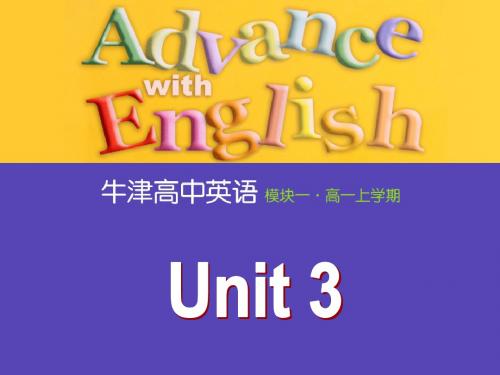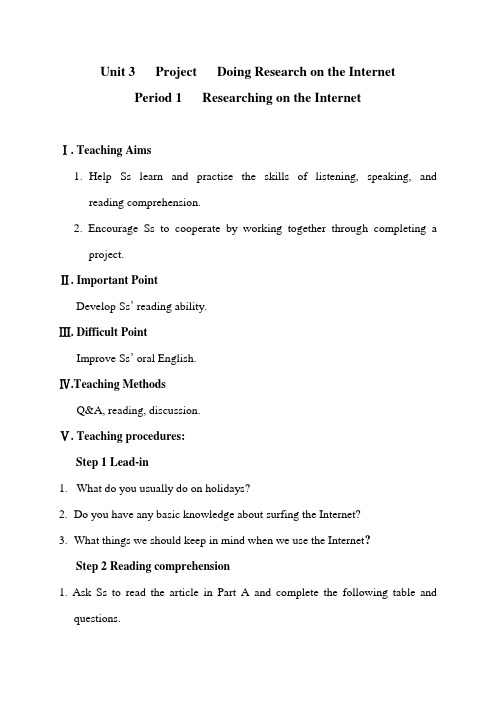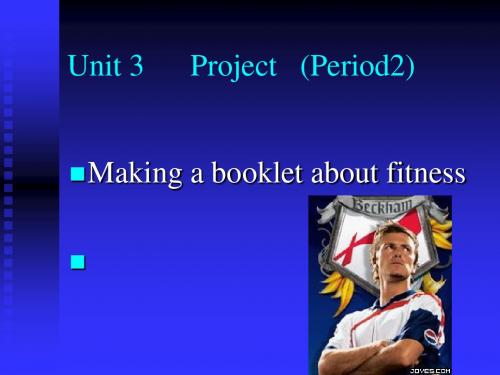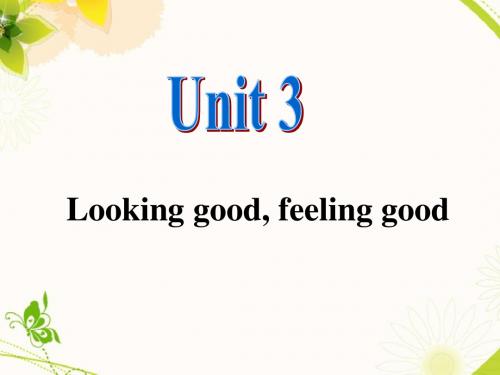牛津英语模块一Unit 3 project(period1)优秀版
- 格式:ppt
- 大小:761.50 KB
- 文档页数:28



Unit 3 Project Doing Research on the InternetPeriod 1 Researching on the InternetⅠ. Teaching Aims1.Help Ss learn and practise the skills of listening, speaking, andreading comprehension.2. Encourage Ss to cooperate by working together through completing aproject.Ⅱ. Important PointDevelop Ss’ reading ability.Ⅲ. Difficult PointImprove Ss’ oral English.Ⅳ.Teaching MethodsQ&A, reading, discussion.Ⅴ. Teaching procedures:Step 1 Lead-in1.What do you usually do on holidays?2.Do you have any basic knowledge about surfing the Internet?3.What things we should keep in mind when we use the Internet?Step 2 Reading comprehension1. Ask Ss to read the article in Part A and complete the following table andquestions.1). Comparison of the two search services:2). ①What are the advantages of the search engines and subject directories?A.Both give you indirect links and the information is chosen andorganized differently.B.Both give you direct links but the information is not chosen andorganized differently.C.Both give you direct links but the information is chosen and organizeddifferently.D.Both give you indirect links and the information is not chosen andorganized differently.②. Which of the following statements is true?A.Search engine is a kind of computer program.B.Search engine is built by computer program.C.Subject directories are a kind of computer program.D.Subject directories provide correct and clear information people need.③. There are several things to take into consideration when you are searching.Which of the following things is NOT true according to the passage?A.The way you type your key words makes a difference.B.The information people put on the Internet is not always correct.C.You had better check the dates you find.D.The language people use is very important.2. Ask Ss the following questions to check whether they know how to do research on the Internet and how to use the information got from the Internet.①. Do you check the date of the website you find when you search the Internet?Why should we check the dates?②. How can we do cross-checking? Why should we do cross-checking?③.What is the usage of double quotation marks in searching information onthe Internet?④. Can we copy the words found on the Internet and use them in our articles?Why not?3. Play the recording once to consolidate what students have learned.Step3. Discussion & PresentationGet Ss work together to discuss the use of the Internet. Ask several Ss to present their opinions 3 minutes later.Step4. Assignment1.Ask Ss to do the reading exercises on page 123 of the Workbook.2. Ask Ss to underline the key words, phrases in the article.Keep in mind; aid; evaluate; comb through; take into consideration; at the bottom of; make a difference; consult; search for; attach。



沪教牛津版四年级上册英语Module 3 Unit 1 In the schoolThe first periodAims and demands:1. Learn the numbers: 11--202. Learn the new pattern: Count the ___s. There is/are …Teaching Design:一、Pre-task1. Sing a song: Ten little rabbits2. Ask and answer:Who’s your friend?What has she/he got?What can she/he do?How is he?Is he afraid or brave?What’s he?3. Introduce your friend4. Revision:1) Fill in the blanks:cherish slice whale clapphysical thumb fly glue2) Fill in the blanks:Alice ______ (have) a skateboard.We can’t ______ (dive).She ______ (not like) robots.We have ten little ______ (finger).That’s ______ (Tim and Mark) brother.Can she ______ (swim)?二、While-taskA: Numbers1. T puts the sweets in the box. Then let Ss guess.Show: seven --- eleveneleven sweetsMake phrases: eleven chairs/desks/…2. Teach other numbers with the same way.twelve thirteen -- thirty fourteen – forty fifteen – fifty sixteen – sixty seventeen – seventy eighteen – eighty nineteen -- ninety3. Read the numbers1. Check the answerT: How many desks? Let’s count. One, two, three … Twenty desks.How many windows? Let’s count. One, two, three … Twelve windows.2. countmouth --- count3. Let Ss say with the example.S1: Count the pencils. S2: _____ pencils.C. Pattern: there be1. T: Count the sweets. There are 15 sweets.2. Show it:There is + 名词单数There are + 名词复数3. Fill in with “there be”______ fifteen apples.______ two apples in the basket.______ an old box on the desk.______ one skateboard.______ twenty robots.4. Practice with the same table.e.g. S1: Count the ______. S2: There is/are …三、Post-task1. Read after the tape.2. Ask and answer on P24.3. Homework:The second periodAims and demands:1. Learn the new words: rope, hoop2. Learn the pattern to ask the quantity and answer.e.g. How many …? There is/are …Teaching Design:一、Pre-task1. Ask and answer1) Have you got a cat?2) Do you like apples?3) Are you tall or short?4) Where are you?5) What can you do?6) What’s your brother?7) What does your father/mother do?8) Whose book is this?2. Revision:1) Recite the numbers from 1 – 202) Draw the fruit on the tree in groups and fill in. Then say it.A: New words: rope hoop1. T shows the object to the Ss. Let them spell the words with the pronunciation.r o p e h o o p2. Make sentencesB: New pattern: How many … are there? There is/are …1. T shows the ropes and says:How many ropes are there? Let’s count. One, two, three … Eighteen ropes. There are eighteen ropes.2. Show: How many ropes are there? There are eighteen ropes.3. Practise it in pairs on P25.4. Change the sentences.There is an exercise book.There are sixteen dogs.There is a policeman.三、Post-task1. Read after the tape.2. Choose1) How many desks? ______ one.A. There areB. There isC. They are2) There ______ a ball and ten hoops in the playground.A. isB. amC. are3) How many ______ are there?A. mouseB. miceC. mouses4) There ______ three windows and one door in my classroom.A. isB. areC. am5) Count the ______. A. rope B. hair C. ropes6) There ______ some milk in the cup.A. isB. areC. am3. Complete the dialogueA: Hi, Tom.B: ______, Ben. ______ have you got?A: I ______ ______ a big bag.B: ______ in it?A: Some books.B: ______ ______ books? Let me ______. One, two, three … eleven. There are ______ books.A: Yes.4. HomeworkThe third periodAims and demands1. Learn the words of shapes: square, triangle, star, rectangle, circle2. Learn the new pronunciation: /dr/ /pr/3. Learn th pattern of asking the shapes: Eg. What shape is it? It’s a …Teaching design:一、Pre-task1. Ask and answerHow many desks are there?How many chairs are there?How many boys are there?How many ropes are there?Is there a rubber? How many plants?2. Fill in the blankspleasure climb sleepdriver draw dryprice prawn press(Asking Ss to conclude the pronunciation of dr, pr.)二、While-taskA: New Words: square, triangle, star, rectangle, circle1. star (T shows the different shapes and ask)1) T: Look at the shapes. They are shapes.Show: sh a p ewhat shape2) T: What shape is it? It’s a star.Show: stand --- star2. square1) (Show the shape)T: Is this a star? What shape is it? It’s a square.What shape is the book? It’s a square.2) Show: queen --- square3. (Teach others with the same way.)triangle rectangle circle4. Read these words.5. Read after the tape.6. Ask and answerS1: How many squares/… ? S2: There is/are …. Read and guess1. T: Guess. It’s a rectangle. It’s blue. What is it?2. Ask and answer in groups三、Post-task1. Read after the tape.2. Change the sentences.1) There is an exercise book in the desk. (划线提问)2) Are there eight kites? (改成肯定句)3) There are eighteen dogs. (划线提问)4) The rabbit’s teeth are big and sharp. (划线提问)5) This is a brown bicycle. (划线提问)3. Homework。